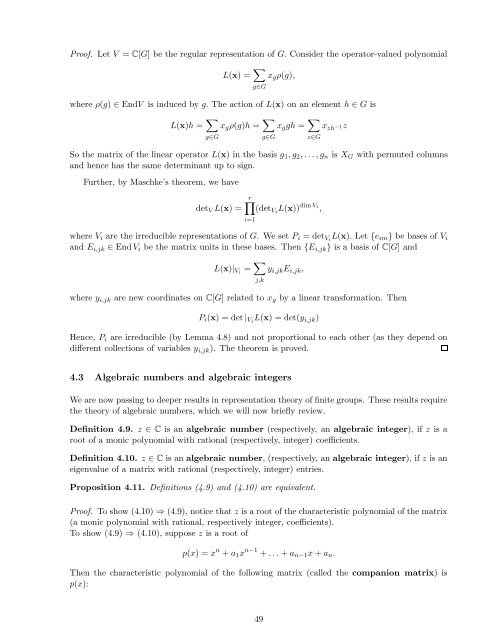Lecture notes for Introduction to Representation Theory
Lecture notes for Introduction to Representation Theory
Lecture notes for Introduction to Representation Theory
You also want an ePaper? Increase the reach of your titles
YUMPU automatically turns print PDFs into web optimized ePapers that Google loves.
Proof. Let V = C[G] be the regular representation of G. Consider the opera<strong>to</strong>r-valued polynomial<br />
L(x) = x g δ(g),<br />
where δ(g) EndV is induced by g. The action of L(x) on an element h G is<br />
gG<br />
L(x)h = x g δ(g)h = x g gh = x zh −1 z<br />
gG gG zG<br />
So the matrix of the linear opera<strong>to</strong>r L(x) in the basis g 1 , g 2 , . . . , g n is X G with permuted columns<br />
and hence has the same determinant up <strong>to</strong> sign.<br />
Further, by Maschke’s theorem, we have<br />
r<br />
det V L(x) = (det Vi L(x)) dim V i<br />
,<br />
i=1<br />
where V i are the irreducible representations of G. We set P i = det Vi L(x). Let {e im } be bases of V i<br />
and E i,jk End V i be the matrix units in these bases. Then {E i,jk } is a basis of C[G] and<br />
L(x) | Vi = y i,jk E i,jk ,<br />
where y i,jk are new coordinates on C[G] related <strong>to</strong> x g by a linear trans<strong>for</strong>mation. Then<br />
j,k<br />
P i (x) = det | L(x) = det(y i,jk )<br />
V i<br />
Hence, P i are irreducible (by Lemma 4.8) and not proportional <strong>to</strong> each other (as they depend on<br />
different collections of variables y i,jk ). The theorem is proved.<br />
4.3 Algebraic numbers and algebraic integers<br />
We are now passing <strong>to</strong> deeper results in representation theory of finite groups. These results require<br />
the theory of algebraic numbers, which we will now briefly review.<br />
Definition 4.9. z C is an algebraic number (respectively, an algebraic integer), if z is a<br />
root of a monic polynomial with rational (respectively, integer) coefficients.<br />
Definition 4.10. z C is an algebraic number, (respectively, an algebraic integer), if z is an<br />
eigenvalue of a matrix with rational (respectively, integer) entries.<br />
Proposition 4.11. Definitions (4.9) and (4.10) are equivalent.<br />
Proof. To show (4.10) ≥ (4.9), notice that z is a root of the characteristic polynomial of the matrix<br />
(a monic polynomial with rational, respectively integer, coefficients).<br />
To show (4.9) ≥ (4.10), suppose z is a root of<br />
p(x) = x n + a 1 x n−1 + . . . + a n−1 x + a n .<br />
Then the characteristic polynomial of the following matrix (called the companion matrix) is<br />
p(x):<br />
49

















